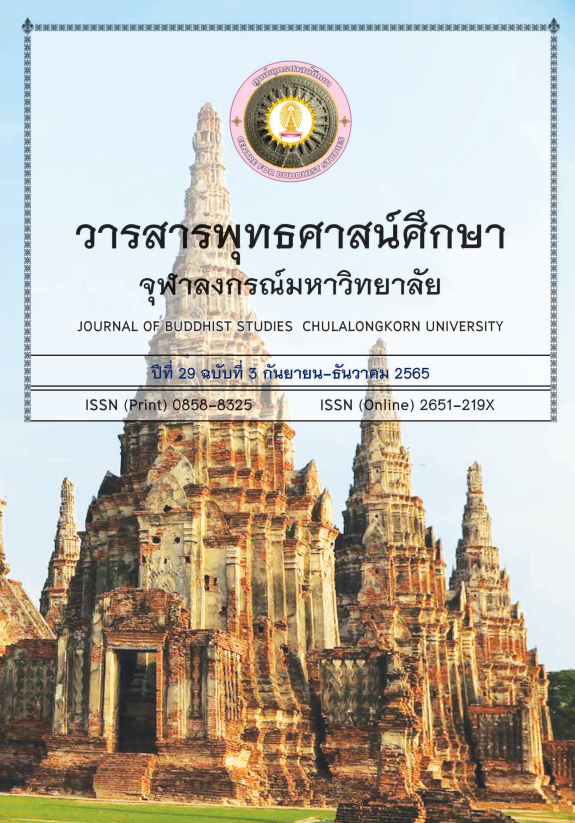ĀPATTI FROM THE PERSPECTIVE OF PENOLOGY
Keywords:
Monastic punishment, Penology, Deterrence theory, Rehabilitative theory, VinayaAbstract
This research article aims to study the monastic punishment in the Vinaya and the Commentary from the perspectives of two penological theories – deterrence theory and rehabilitative theory – as well as to analyze the relationship between the monastic offense and the five parts of Buddhism, i.e. the monastic community, the perpetrating monk, other monks, laypeople, and the religion, according to the Buddha’s objectives in the legislation of monastic orders. The research found that the three categories of monastic punishment – expulsion from monkhood, probation, and confession – are consistent with the principles of both penological theories. From the perspective of deterrence theory, punishments undermine future opportunities, are of great inconvenience, and disgrace the perpetrator, respectively. From the perspective of rehabilitative theory, the punishments are expulsion from monkhood in order to remain in a different but more appropriate status, exclusion from monkhood for correction, and expression of penitence. Apatti can be considered either as deterrence or rehabilitation, depending on the conscience of the perpetrating monk. It is deterrence for remorseless monks so that they may be law-abiding, while it is rehabilitation for those who are well-behaved to liberated ones who have attained the spiritual goal. The 5 parts of Buddhism are stakeholders in monastic offense and play a role in monks’ following of disciplinary rules and control of sense-faculties. The study shows that monastic punishments are self-correction of the wrongdoing. Having committed an offense, a monk should admit it and join the process of correction as soon as he realizes it.
Downloads
References
นัทธี จิตสว่าง. (2541). หลักทัณฑวิทยา: หลักการวิเคราะห์ระบบงานราชทัณฑ์. กรุงเทพมหานคร: Imprint.
พระพรหมคุณาภรณ์ (ป.อ.ปยุตฺโต). (2545). การศึกษาฉบับง่าย Education Made Easy. กรุงเทพมหานคร: มูลนิธิพุทธธรรม.
พระพรหมคุณาภรณ์ (ป.อ.ปยุตฺโต). (2551). พจนานุกรมพุทธศาสน์ ฉบับประมวล ศัพท์. กรุงเทพมหานคร: มหาจุฬาลงกรณราชวิทยาลัย.
พระมหาโพธิวงศาจารย์ (ทองดี สุรเตโช). (2561). พระวินัยบัญญัติ. กรุงเทพมหานคร. รุ่งศิลป์การพิมพ์.
พเยาว์ ศรีแสงทอง. (2555). การลงโทษและการแก้ไขผู้กระทําผิด (Punishment and correction). กรุงเทพมหานคร. จามจุรีโปรดักส์.
พรชัย ขันตี, กฤษณพงค์ พูตระกูล, จอมเดช ตรีเมฆ. (2558). ทฤษฎีอาชญาวิทยา (พิมพ์ครั้งที่ 1). กรุงเทพมหานคร. ส.เจริญการพิมพ์.
มหาจุฬาลงกรณราชวิทยาลัย. (2539). พระไตรปิฎกภาษาไทย ฉบับมหาจุฬา ลงกรณราชวิทยาลัย . กรุงเทพมหานคร.
มหาจุฬาลงกรณราชวิทยาลัย. มหามกุฏราชวิทยาลัย. (2538). สฺยามรฏฐสฺส เตปิฏกํ. กรุงเทพมหานคร. มหามกุฏราชวิทยาลัย.
มหามกุฏราชวิทยาลัย. (2552). สมนฺตปาสาทิกา นาม วินยฏฐกถา. กรุงเทพมหานคร. มหามกุฏราชวิทยาลัย.
มหามกุฏราชวิทยาลัย. (2559). พระไตรปิฎกและอรรถกถาแปล. นครปฐม. มหามกุฏราชวิทยาลัย.
สมเด็จพระพุทธโฆษาจารย์ (ป.อ.ปยุตฺโต). (2558). พุทธธรรม ฉบับปรับขยาย. กรุงเทพมหานคร: ผลิธรรม.
สมเด็จพระมหาสมณเจ้า กรมพระยาวชิรญาณวโรรส. (2541-2555). วินัยมุข เล่ม 1-3. กรุงเทพมหานคร. มหามกุฏราชวิทยาลัย.
สมพรนุช ตันศรีสุข. (2022). อาบัติลักทรัพย์ในทุติยปาราชิก. วารสารธรรมธารา. 8 (1), 80-121.
สุเนติ คงเทพ. (2557). รอการลงโทษ: ภาคทฤษฎีและภาคปฏิบัติ (พิมพ์ครั้งที่ 1). กรุงเทพมหานคร: นิติธรรม.
สุนทร สุขทรัพย์ทวีผล. (2559). การแก้ไขผู้กระทําผิดเชิงพุทธ. ว.มรม. (มนุษยศาสตร์ และสังคมศาสตร์), 10(1), 19-25.
สุภาพรรณ ณ บางช้าง. (2550). รัตนประทีปแห่งพระไตรปิฎก พระวินัยปิฎก (พิมพ์ครั้งที่ 1). กรุงเทพมหานคร: คราฟแมนเพรส จํากัด.
อัจฉริยา ธิรศริโชติ. (2552). ยุติธรรมเชิงสมานฉันทในพระวินัยปิฎก. (วิทยานิพนธ์ ปริญญามหาบัณฑิต จุฬาลงกรณ์มหาวิทยาลัย).
อัณณพ ชูบํารุง. (2540). อาชญาวิทยาแนวพุทธ BUDDHIST CRIMINOLOGY. (พิมพ์ครั้งที่ 1). กรุงเทพมหานคร. ชุมนุมสหกรณ์การเกษตรแห่ง ประเทศไทย
Downloads
Published
How to Cite
Issue
Section
License
Copyright (c) 2022 Chulalongkorn University Centre for Buddhist Studies

This work is licensed under a Creative Commons Attribution-NonCommercial-NoDerivatives 4.0 International License.
บทความที่ได้รับการตีพิมพ์เป็นลิขสิทธิ์ของศูนย์พุทธศาสน์ จุฬาลงกรณ์มหาวิทยาลัย
ข้อความที่ปรากฏในบทความแต่ละเรื่องในวารสารวิชาการเล่มนี้เป็นความคิดเห็นส่วนตัวของผู้เขียนแต่ละท่านไม่เกี่ยวข้องกับศูนย์พุทธศาสน์ จุฬาลงกรณ์มหาวิทยาลัย และคณาจารย์ท่านอื่นๆในมหาวิทยาลัยฯ แต่อย่างใด ความรับผิดชอบองค์ประกอบทั้งหมดของบทความแต่ละเรื่องเป็นของผู้เขียนแต่ละท่าน หากมีความผิดพลาดใดๆ ผู้เขียนแต่ละท่านจะรับผิดชอบบทความของตนเองแต่ผู้เดียว






